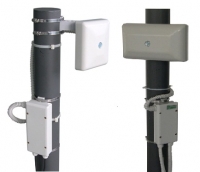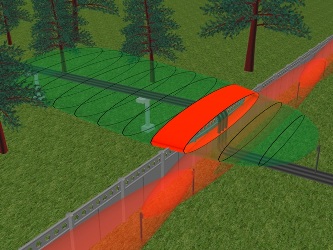| Division of the detection zone into several subzones using the example of ZEBRA-30 and ZEBRA-60 single-position radio wave detectors
Division of the detection zone into several subzones using the example of ZEBRA-30 and ZEBRA-60 single-position radio wave detectors Radio wave single-position detectors ZEBRA-30 and ZEBRA-60 have a detection zone divided into 12 subzones in the direction of radiation. This is a fundamental and very important advantage of these single-position security detectors compared to any other single-position radio wave detectors of both domestic and foreign production. The ZEBRA-30 and ZEBRA-60 detectors provide the ability to turn on/off any or several subzones simultaneously. The subzone disabling algorithm currently has no analogues in Russia. Why is this necessary, what are the advantages and under what conditions are they clearly manifested? Firstly, this is an increase in noise immunity — the most important task for single-position detectors. The ZEBRA-30 and ZEBRA-60 detectors use highly intelligent processing algorithms, due to which they demonstrate excellent noise immunity indicators in comparison with single-position detectors from other manufacturers. This is achieved by separate processing of the useful signal and setting the sensitivity in each of the 12 subzones.
The second important feature of these detectors is the ability to disable any of the subzones or several subzones in any sequence. This may be necessary and convenient when organizing «authorized» passages. For example, for the passage of vehicles through gates or for the movement of people through wickets in a fence, as shown in Figure 1. Figure 2 shows a variant of pipeline protection using the ZEBRA-60 detector. This variant of application especially clearly shows how significantly the noise immunity is increased, since only one of the 12 subzones is enabled. Any interference or false alarm in the «disabled» subzone will not cause a general alarm. When installing detectors on the wall of a building to protect against penetration through windows or doorways, it is advisable to enable and use only those subzones in whose coverage area there are windows and doors. Disabling other subzones will increase noise immunity.
Distinctive features. Subzones are enabled/disabled and their sensitivity is adjusted in the ZEBRA-30, ZEBRA-60 alarms using controls located on the body or using a connected computer via the USB interface. «ANTI-MASKING» — allows you to determine the intentional masking of a part of the protected area to commit unauthorized actions, for example, masking approaches to the protected object with a large metal sheet. The detector has an extended range of supply voltage of 5…30 V, which reduces the requirements for supply voltage and cables at sites. Various shapes of the ZEBRA-60 detection zone (volume, curtain, fan) allow expanding the scope of application of a single-position detector, which can protect both linear (perimeter) sections and area (walls, ceiling, roof, adjacent territories). Maximum length of the detection zone: ZEBRA-60 — 60 meters, ZEBRA-30 — 30 meters. The length of the detector's detection zone is adjusted by sequentially disabling subzones. The resolution (length of the subzone) of the change in the detection zone length for the ZEBRA-60 detector is 5 m, for the ZEBRA-30 detector — 2.5 m. ZAO «OKHRANNAYA TEKHNIKA» is developing detectors with detection zone lengths of 10 m and 60 m. In addition, work is underway to increase the number of subzones to 16-20. |



